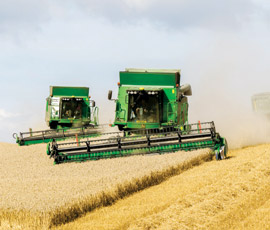Wheat production drops by 10%

English farmers are likely to harvest 11.74m tonnes of wheat this year, according to preliminary figures from Defra and the NFU – almost 10% down on last year.
Defra’s June survey revealed that total wheat plantings – hampered by last year’s difficult autumn weather – were the smallest since the early 1980s, at 1.505m ha.
That was 19% down on last year’s acreage.
But yields have been 16% better, according to the NFU’s harvest survey, at 7.8t/ha – slightly above the five-year average of 7.7t/ha.
The smaller wheat crop meant the UK was likely to import above-normal volumes of wheat for the second year running, said Andrew Watts chairman of the NFU combinable crops board.
“If, as we are seeing, the quality is excellent, that will be some comfort for producers,” he added.
“I would hope it would mean British companies using a higher proportion of British wheat in their products, which would be good news for consumers.”
Winter barley plantings fell by 22%, to 257,000ha; but a 94% jump in spring barley acreage meant the total barley area was the largest since 2001, at 828,000ha.
It was a similar picture with the oilseed rape crop, with winter plantings down 17%, to 584,000ha and the spring crop area increasing more than eight-fold, to 92,000ha.
“This led to an overall oilseed rape area of 676,000ha, which despite being a 5.1% decrease from 2012, is still the second largest area of oilseed rape on record,” said the Defra report.
English oat plantings increased by 50% on last year, to 138,000ha – the largest area since the late 1970s.
And the area of linseed, field beans and peas increased by 24%, 26% and 21%, respectively.
“Many arable farmers are still working under the shadow of 2012’s appalling weather and the knock-on impact this has had,” said Mr Watts.
“I think we are all relieved to draw a line under this season. Let’s hope we can make a good start planting this autumn and, weather willing, see a productive harvest next year.”

